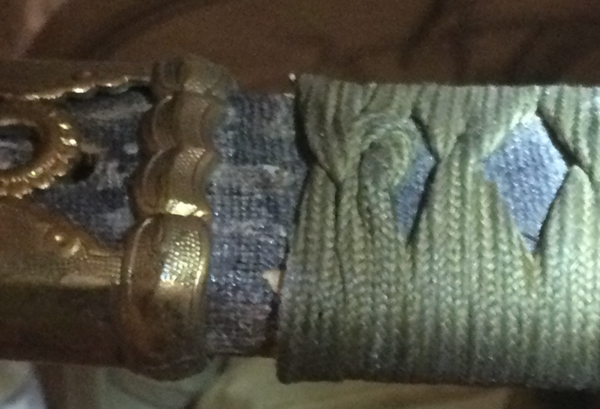
John C
Members-
Posts
2,621 -
Joined
-
Last visited
-
Days Won
17
Content Type
Profiles
Forums
Events
Store
Downloads
Gallery
Everything posted by John C
-
Showa smith Munetsugu (Tanaka?) info, please.
John C replied to John C's topic in Military Swords of Japan
Thank you Malcolm and Bruce. Yes, I saw that. However I was not sure if the Shimotsuke mei was maybe an artist name for Tanaka Munetsugu or a different person. John C. -
Does anyone have any oshigata or other information on a showa smith named Munetsugu? I have found one reference (name only) for a Tanaka Munetsugu, who was a mediocre RJT smith. I cannot find any other references or examples of his mei. Thank you, John C.
-
Hello: I am trying to figure out what this kurikata is made out of. My guess is some type of Bakelite. Looks dark until light shines on it, then depending on the angle of the light different colors emerge. It's on a tanto probably from the early part of the 20th century. I have only come across references to buffalo horn and wood, though bakelite was used on some handles and tunic buttons on war stuff. Thank you for taking a look, John C.
-
Hard to say. But under a loupe, the edge of one of the chips looks black, which may indicate it was dyed then lacquered to give a shine. John C.
-
It's a gifu in a sakura flower stamp (upside down). Possibly used by Seki Cutlery. See Bruce Pennington's excellent stamp document for further information. John C.
-
I took another look at mine. It appears to be the type of black canvas Thomas spoke about. I apologize to everyone for the incorrect information. John C.
-
Conway: I believe the same' used on souvenirs is a type of celluloid, which they did use on some swords toward the end of the war. John C.
-
kozuka theme identification help
John C replied to John C's topic in General Nihonto Related Discussion
Thank you both very much! John C. -
Hello: I recently picked up this cheap (and probably newer) kogatana and would be interested in knowing the theme. Does anyone recognize this? The kozuka is unsigned; the mei on the kogatana is unreadable. Thank you, John C.
-
Eric: I had one with cosmoline. It had turned a dingy hard yellow. I removed it so I could not only see the blade but also oil it properly. There are some discussions on NMB about removing it (search cosmoline). John C.
-
Japanese Sword Etiquette - Warning Graphical Content
John C replied to vajo's topic in General Nihonto Related Discussion
Chris: Did you throw in a ringer? Isn't this your safe? John C. -
The author was conducting a qualitative study rather than a quantitative one. In a thematic (case) study, the N does not need to be as large as it would need to be to conduct inferential statistics. Indeed, I have seen case studies done with an N of 5. Qualitative analysis software makes the job of pulling out themes a lot easier than it used to be. John C.
-
How are kozuka attached to kogatana?
John C replied to John C's topic in General Nihonto Related Discussion
Thank you everyone. This is great information. John C -
I imagine this is a simple question to those who know, however I have not been able to find an answer through researching threads. Is it simply a friction fit (allowing for replacing the kogatana as it wears out) or were these glued in place? John C.
-
Larry: It looks legit to me. Here is a site to get you started. http://ohmura-study.net/945.html John C.
-
Identify odd pair of swords
John C replied to John C's topic in Auctions and Online Sales or Sellers
Jean: Not interested in buying, just curious whether or not these were maybe Thai or some other southeast asian manufacture. But I agree, whatever they are, 750 is already too high. John C. -
Can anyone identify the origin of these swords? The writing does not look like Japanese to me. The kabutogane has what looks like a shamrock design. ??? John C. https://shopgoodwill.com/item/174769386
-
-
Brandon: Values are not generally discussed because they are so subjective. The individual swordsmith, the year, the style of sword (type 98, mantetsu, gendaito, etc.), all play a part in value. It is a nice example. You can, however, get a sense of value by looking at online auctions for similar swords and smith. Some of the information linked by Ray may help in that. John C.
-
Okay. So the Processing Military Swords doc only applies to RJT. Got it. Makes more sense now when I separate procedures for RJT gendaito from standard military production. Thanks, all. John C.
-
With a cut that deep, it seems as if that area of the ha had not been hardened appropriately. John C.
-
I have always wondered about that. Below is an excerpt from the Specifications for Processing Military Swords: 11. The blacksmith (including quenching) and the engraver must be the same person. But it has been noted many times on this forum that shops had mei cutters. Are there any "evidentiary" documents that support the notion of a specified mei cutter? I'm not doubting it, just would like to have a copy of the document. John C.
-
Bruce: Google app has what you wrote in the title as "last generation." But is this an extra stroke in the first kanji? John C.












